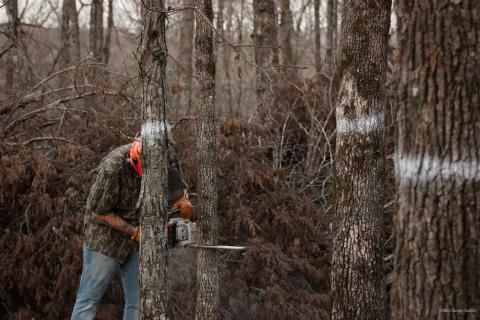“Reaching Out” For Slabs
Tommy Skarlis
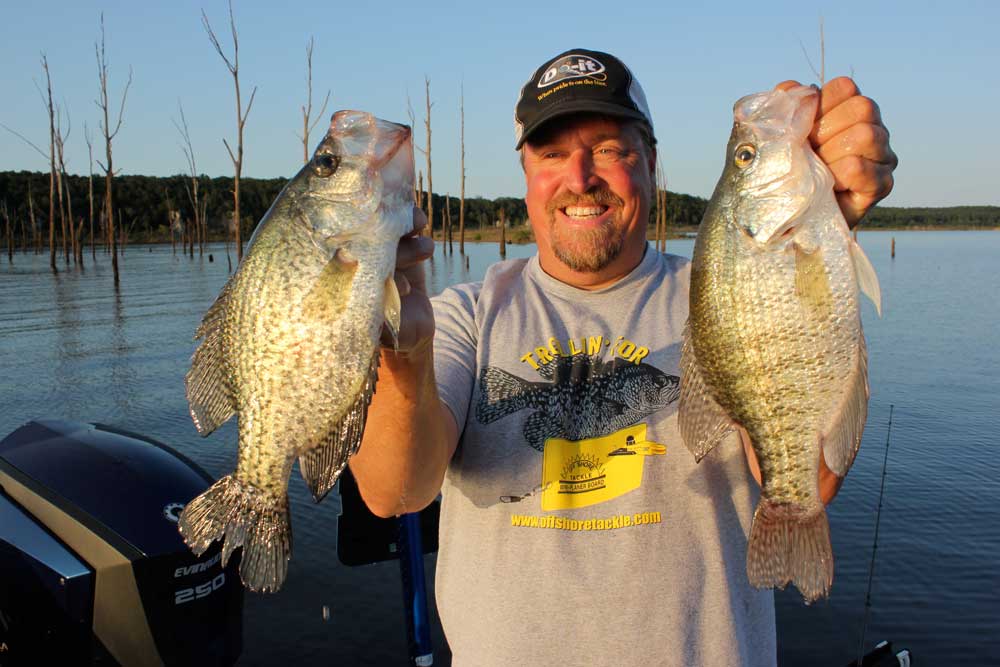
Crappies, probably America’s favorite fish, are both a “forage base” and “predators” at the same time. Other fish are, too, but crappies have to be more on guard. They school-up for protection from big catfish, pike, and muskies, and can become super wary. And, during fall, they often move and suspend in basically nothingness.
Those factors make trolling boards super effective. It’s a “stealthy” approach, but coverage is the key. Boards transform a boat from a tractor into a combine.
My partner Kyle Steinfeldt and I won the 2013 Bass Pro Shops Crappie Masters Championship by pulling crankbaits with Off-Shore OR12 Side Planers. The tournament took place in September on Lake Grenada in Mississippi. We pulled big crankbaits, walleye-size #5 and #6 Berkley Flicker Shads and size #4 and #5 Salmo Hornets at .8 to 1.2 mph to rack up a total of 27.83 pounds of slabs in two days for the win. The average size was around 2 pounds.
By using “line counter reels,” 10-pound test monofilament, and St. Croix Eyecon trolling rods, we pulled 6 boards - three off each side of the boat. The lures were placed 56 to 77 feet behind the boards. When it was overcast, fluorescent or solid colors worked best, but when it was bright, chrome patterns excelled. The crappies were outside of stands of submerged timber on big sand flats about 14 to 16-feet deep. Without cover, crappies are very wary, a situation that screams for “boards.”
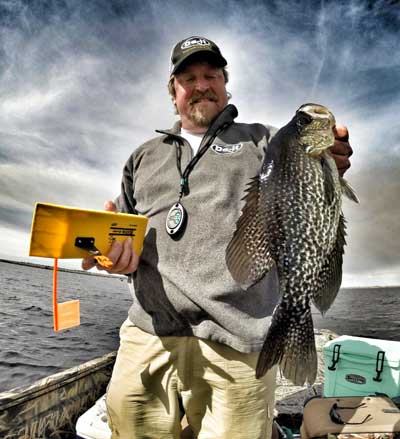
boards – from jigs, to crankbaits to live bait.
Getting lures well away from the boat was a key. When crappies spread out in clear water, approaching close with the boat is not effective.
Anglers often ask, “Why not use braided lines?” I sometimes do, but monofilament provided a crucial advantage in the tournament. Sometimes, when crappies touch baits trolled on braid, they immediately spit it. The stretch in mono seems to encourage fish to hang on until it’s too late.
In the North, during the fall, crappies invade nondescript basin areas in natural lakes. A wide spread with trolling boards is an exceptional tactic for finding crappies on and over those endless flats. During fall, hunt deeper flats, humps and rock piles using either crankbaits or jigs tipped with plastics. Crappies might be suspended 10 to 20 feet down, especially early in fall, or even near the bottom over 40-foot flats later on. That’s when I hunt for those classic “Christmas tree” shapes with my sonar.
Boards offer precise depth control. Distance behind the board determines depth, whether it’s a jig or a crankbait. Tether it with a short 10-foot lead to get over shallow brush piles and weed beds. Or just use different jigs, from 1/32 up to 3/8-ounce. A 3/8-ounce jig going .7 to 1 mph is getting down about 5 feet on a 10-foot lead - double it to get down 10 feet, and so on.
By late fall, when crappies are hugging the bottom, let out line until the jig ticks bottom, clip it to the board and send it out. Look at the angle of the line behind the board and you can gauge the running depth with fair accuracy as you change speeds. Run 4 boards and let the fish tell you which bait hits the strike zone, anywhere between 20 feet deep and the surface.
On those deeper flats, I find the effective range of line length by holding onto the rod and letting out line a little at a time. When it starts clicking the bottom across the tops of deep structure or right on the floor along basin transitions (from soft to hard bottom), I note the numbers on the line counter and start clipping those lines to boards to spread my coverage and zero in. Knowing how much line you have out before attaching the board is crucial; this is why line-counter reels are important.
A 1/16-ounce jig tipped with a white, pink-white, or chartreuse 2-inch grub or plastic minnow trolled at .8 to 1 mph can rake in fall crappies once the right depth is located. Try different line lengths and a spread of varying colors to zero in. At those speeds, spinner heads and flicker spoon-style jigs, like the Blakemore Road Runner and PK Lures Predator, work great, too. Off Shore tadpoles, an in-line diving weight, are great to use to get light jigs and plain minnow rigs down to the proper depth, without letting out too much line!
Speed Kills
Crappies often respond best to super slow speeds. I sometimes use a transom-mounted electric trolling motor to push the back of the boat into the waves to slow the boat down - slower speeds than a kicker motor can provide. But, when the wind blows, a bow-mount trolling motor is far more efficient.
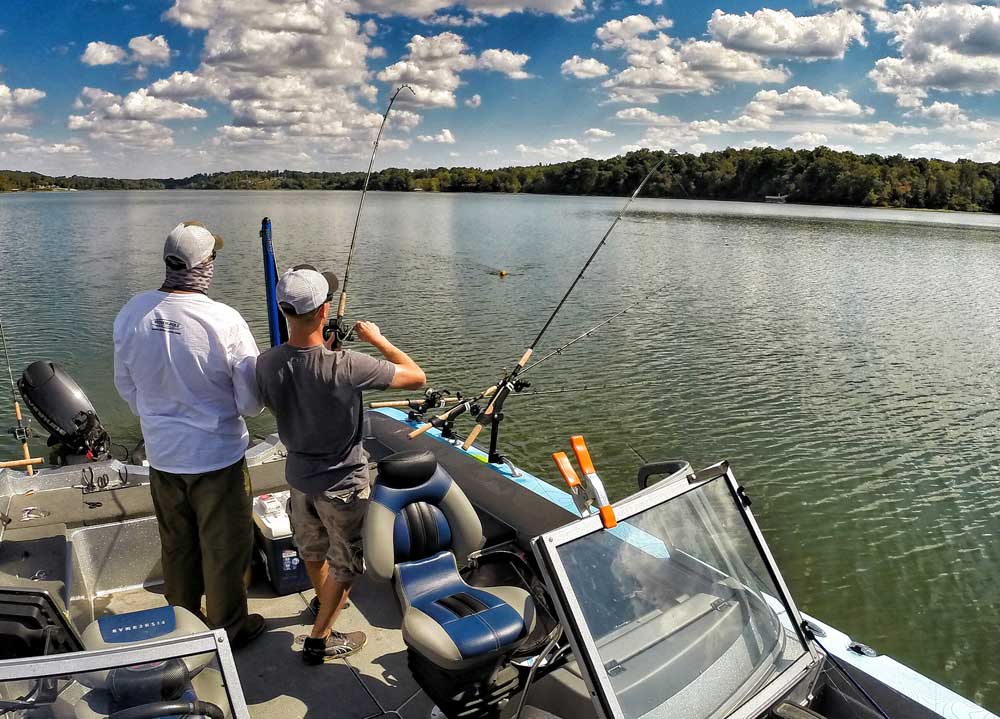
More often than not, the most effective speed is somewhere between .8 and 2 mph, though sometimes as fast as 3 mph. Slowing things down actually makes lures shake more and roll wider—not so quick and tight. The rhythm is sexier at slow speeds, leaving you the option of speeding up to trigger strikes with that fast, tight wobble. With aggressive fish, you can speed up.
It pays to think about having a fast spread when crappies are aggressive and a slow spread for neutral fish. Each spread calls for its own lure sizes and types. You have to downsize with a slow spread. Smaller lures seem to work better at slower speeds, but big, aggressive crappies often respond better to big baits - something that seldom ceases to amaze most crappie fanatics.
With a slow spread, you can get away with “Off Shore OR-38 Crappie Boards,” which detect lighter bites and you can use any conventional spinning or casting set-ups. But pulling bigger boards, like the Off Shore OR-12’s, requires some length and backbone, which is why I like 8.5-foot, medium-power rods.
My line-counters are filled with 10-pound XT. Leaders are not required unless the water is crystal clear. Then I might tie in a few feet of 8-pound fluorocarbon behind a swivel - tie in the swivel about 3 feet up the line either way. Small crappies may not pull the bigger boards back. If they start spiraling back there, line can really twist up.
In the Crappie Masters Championship, we used bigger Off Shore Tackle OR12 Side Planers and Tattle Flags. Our planers had to be so far from the boat we needed the added visibility the larger units provide. And to get that far from the boat, you need a bigger board. Lines were so far out we put extensions on our rod holders, putting outside rods higher in the air so boards wouldn’t tangle.
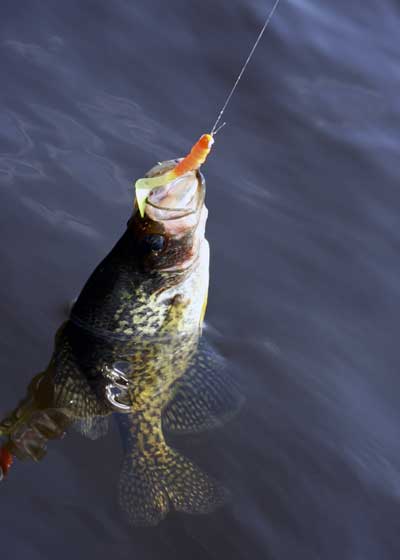
different types of structure and various parts of the water
column. At times they can be very wary or skittish.
I first tried boards for crappies years ago on Red Lake in Minnesota. We couldn’t catch a thing until we slowed way, way down. Lure size isn’t the issue so much as speed. During pre-fishing, we trolled at 2 to 3 mph, but we were hunting for the best areas. In this “search mode,” we averaged 5 fish per day. We also used side-vision sonar to spot schools up to 100 feet from the boat.
Once we figured out what the crappies looked like on the sonar and put a couple areas together, then we slowed down. On the last day of practice, we slowed to 1 mph and immediately caught a 16-inch crappie. Before we could boat it we had another one on and ended up catching 20 fish that day and 27 Grenada “monsters” the first day of the tournament. Obviously, speed is critical, so pay attention and keep adjusting until crappies announce what they like for the speed limit.
With lures down 12 feet, over 14 to 16-feet deep flats, if that board wasn’t 100 feet away from the boat we were not getting bites. The outside boards were 200 feet out, and produced most of the action. Put it out 70 or 80 feet and nothing happened until it pulled a lure that ran higher in the water column. Crappies hit baits near the surface with boards less than 30 feet from the boat, but they wouldn’t touch deeper lures that close.
Trolling is a great way to find crappies during the fall. You can turn around and target them with slip floats or fixed-float presentations, or beat up on them by casting jigs and plastics. But if they’re spread out and you’re really being successful, why change what you’re doing?
I stick with trolling at least half the time. Boards are versatile, too. Anything can be pulled behind a board, including spinner heads, tube jigs, small spinner baits, floating minnow baits - even plain hooks dressed with minnows.
From what I’ve seen, crappies are certainly more afraid of moving boats than moving boards. Running jigs or lures close to a board spooks crappies far less often than we originally thought. It could be that the planer board attracts their attention. The water disturbance, the color, the vibration - crappies might actually be drawn to it, but crappie anglers are not…at least not yet. I suppose that’s another reason why it’s so effective.
Theoretically, boats push crappies off to the side and into the path of the boards, and that’s probably true. Even if it’s not true, boards expand your coverage far better than any other tactic. When crappies scatter out in the desert during fall, nothing finds them faster than boards.














